Table of Contents
- iPhones (2007)
- iPhone 3G (2008)
- iPhone 3GS (2009)
- iPhone 4 (2010)
- iPhone 4s (2011)
- iPhone 5 (2012)
- iPhone 5s (2013)
- iPhone 5c (2013)
- iPhone 6 and iPhone 6 Plus (2014)
- iPhone 6s and iPhone 6s Plus (2015)
- iPhone SE – 1st generation (2016)
- iPhone 7 and iPhone 7 Plus (2016)
- iPhone 8 and 8 Plus (2017)
- iPhone X (2017)
- iPhone XS and iPhone XS Max (2018)
- iPhone XR (2018)
- iPhone 11, iPhone Pro and iPhone 11 Pro Max (2019)
- iPhone SE – 2nd generation (2020)
- iPhone 12 mini, iPhone 12, iPhone 12 Pro and iPhone 12 Pro Max (2020)
- iPhone 13 mini, iPhone 13, iPhone 13 Pro and iPhone 13 Pro Max (2021)
- iPhone SE – 3st generation (2022)
- iPhone 14, iPhone 14 Plus, iPhone 14 Pro and iPhone 14 Pro Max (2022)
- iPhone 15, iPhone 15 Plus, iPhone 15 Pro and iPhone 15 Pro Max (2023)
Ever since Steve Jobs, the then CEO of Apple, surprised the world with the announcement of the first iPhone in 2007, this little device has earned a special place in our hearts and pockets. Not only did it revolutionize how we communicate, work and play, but it also completely changed our perception of what a smartphone could be. With touch screens, the iPhone brought a revolution that ushered in an unparalleled technological era. Today, we will explore the history and evolution of this iconic device that marked the history of humanity, highlighting the main innovations of each generation and the main models launched to date.
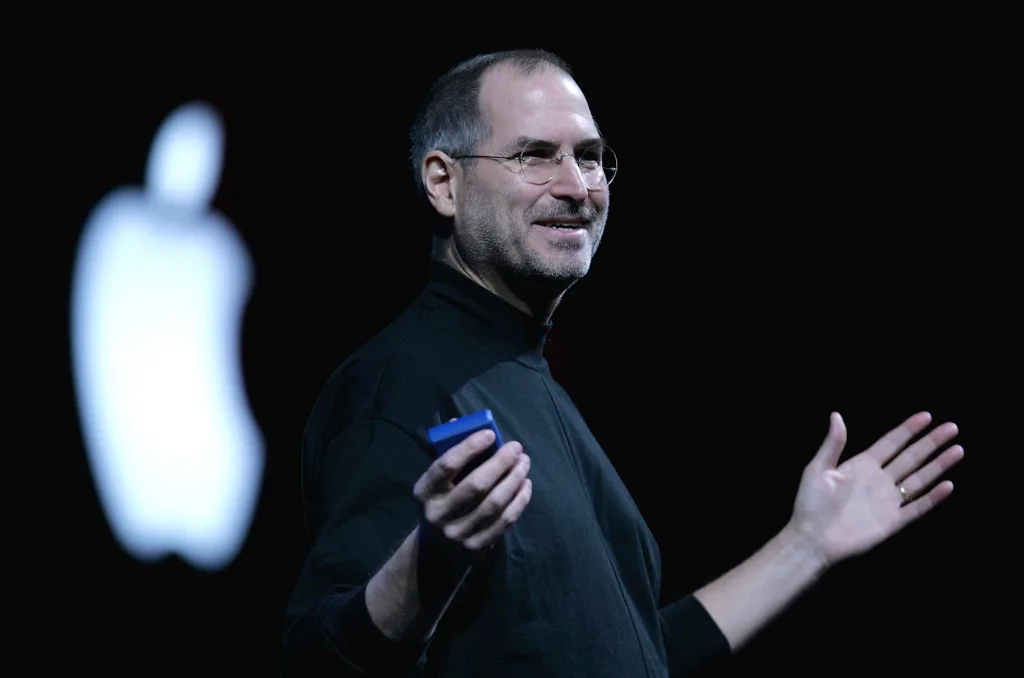
Apple before the iPhone
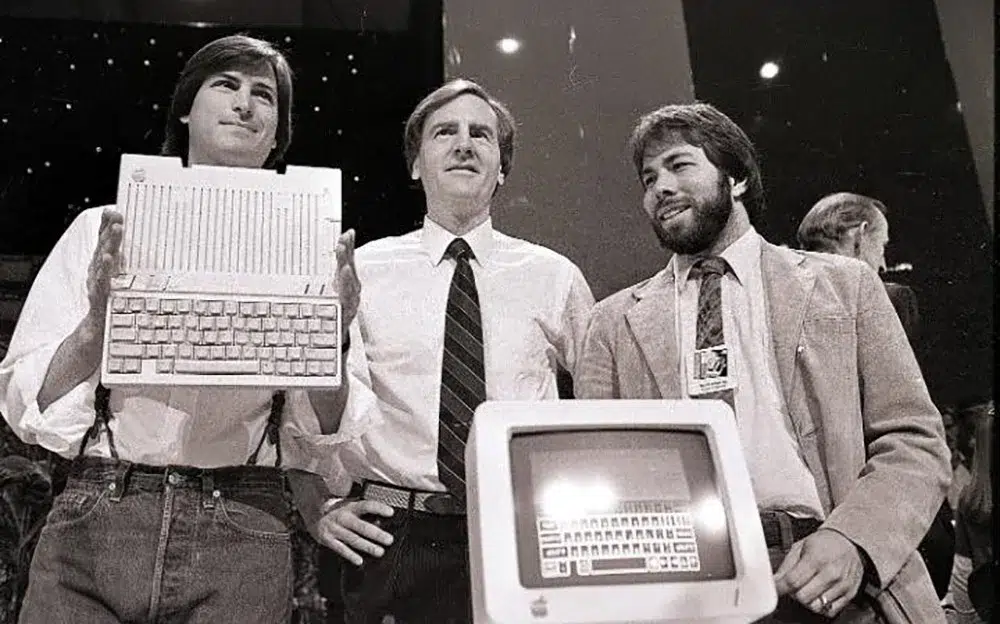
A Apple was founded by Steve Jobs, Steve Wozniak e Ronald Wayne em April 1, 1976, with the initial objective of producing personal computers. In 1977, they launched the Apple II, which became a huge success. The year 1984 was marked as a turning point in the company's history with the launch of Macintosh, a personal computer that featured a graphical user interface that was revolutionary for its time.
Despite the success, in 1985, internal conflicts led to Steve Jobs' departure from Apple. During his absence, Apple faced difficulties, launching products such as Macintosh Portable and the Newton, which did not achieve the expected success. In 1997, Steve Jobs returned to Apple after the acquisition of NeXT, a company he founded. His return as CEO marked the beginning of the company's revitalization.
Between 1998 and 2000, Apple launched products such as iMac, iBook and the power mac g4, which helped the company regain its presence in the market. In 2001, it introduced the iPod, a digital music player that became a huge success and established the brand as a leader in digital entertainment. In 2003, it launched the iTunes Store, allowing users to purchase music digitally and sync it to their iPods.
However, it was in 2007 that Apple presented a device that would change the world forever. When Steve Jobs took the stage and presented the first iPhone na Macworld Expo the technology market has never been the same. The iPhone, launched in June 29th, 2007, marked the beginning of a new era for Apple, revolutionizing the entire mobile phone industry.
The importance of the launch of the iPhone
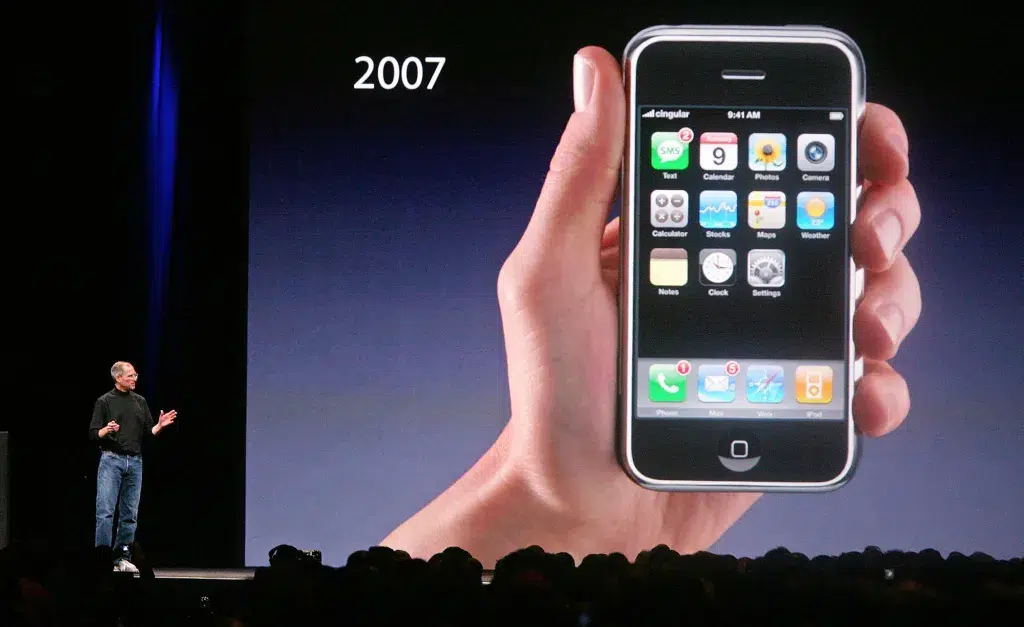
The importance of the iPhone is indisputable, as it truly transformed the mobile phone industry and revolutionized the way we interact with technology. This device introduced the concept of “smartphone” accessible and easy to use and paved the way for a new era in which mobile devices have become important parts of our lives.
The iPhone brought the idea of bringing together several functions in a single device, being a phone, music player, camera, web browser and much more, all in one place. One of the great highlights and innovations of the time was the safari which allowed you to browse the web in full screen. This enabled people to access websites in the same way as on a computer, boosting the use of mobile internet.
A App Store, launched with the iPhone 3G in 2008, also played a key role in the device's importance. This platform allowed developers to create and distribute applications, sparking an application industry that grew very quickly. This also expanded the device's capabilities, making it a custom device for a wide variety of tasks.
Finally, there's no way to talk about the iPhone without mentioning the iOS. This smartphone revolutionized the world of mobile devices by introducing its own operating system, becoming synonymous with innovation and usability. iOS has not only transformed the way we interact with our devices, but it has also set new standards in the industry. With an intuitive interface, elegant design, and a vast and diverse app store, iOS quickly gained a loyal user base.
Additionally, regular iOS updates continue to improve security, performance, and features, ensuring a high-quality user experience. Since its launch, iOS has become one of the most influential and successful mobile operating systems in the world, profoundly shaping how we use our smartphones and mobile devices.
iPhones (2007)

iOS Updates: OS 1.0 – 1.1
O first iPhone of history, released in June 29th, 2007 During the Macworld Expo, it was named simply as the iPhone, and despite not having support for 3G and only having 4 GB, 8 GB and 16 GB models, it was considered a revolutionary model at the time. In his introduction, Steve Jobs called it “a revolutionary iPod, a revolutionary cell phone and a revolutionary internet device”, emphasizing that it would combine three essential functions in a single device, simplifying users' lives.
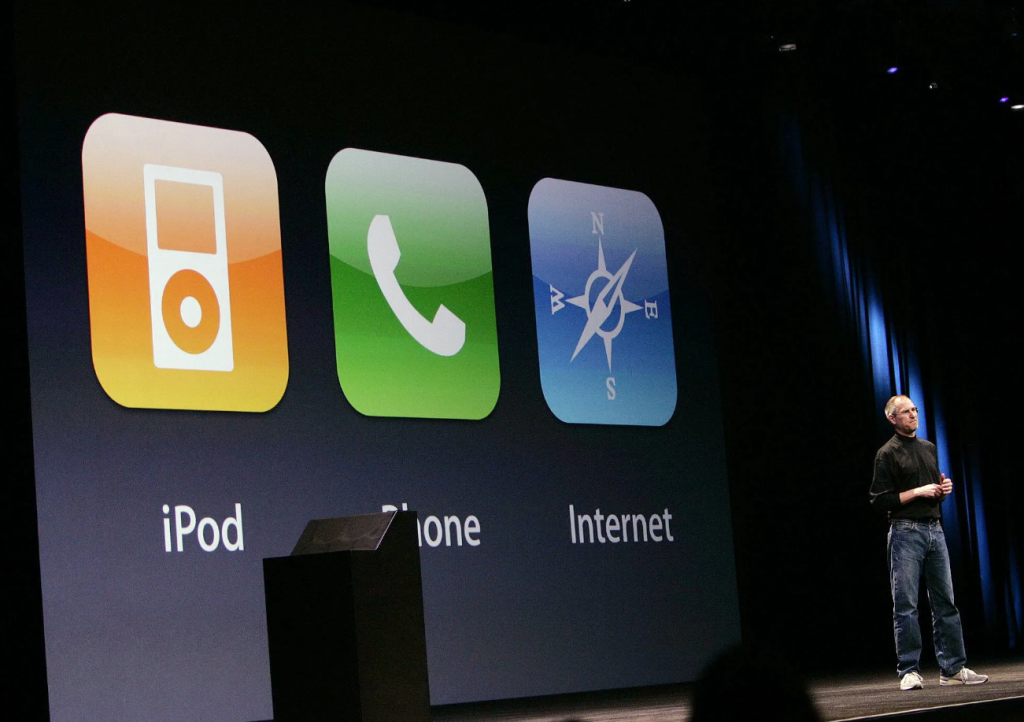
One of the most notable aspects of the presentation was the introduction of 3,5-inch multi-touch screen, which allowed users to interact with the iPhone intuitively and without the need for physical keys. Another highlighted point was the inclusion of the browser safari, which promised to deliver a full-size web browsing experience, something that was uncommon on mobile devices at that time. He also emphasized the iPhone's ability to sync with the iTunes, making it easier for users to transfer music, videos, and other content from their computer to their device.
The iPhone also created integration with email and messaging, making managing personal and professional communications more efficient. Some other highlights of this first device were the 2 megapixel camera and the battery that offered up to 5 hours of talk time, 16 hours of audio playback e até 7 hours of video playback.
iPhone 3G (2008)

iOS Updates: OS 2.0 – 2.2
O iPhone 3G, which marked the official debut of Apple's smartphone in the Brazilian market, was launched in 11 July 2008 as an evolution of the original model. In terms of design, the iPhone 3G maintained the iconic shape introduced in the original model, but with a small change in its back that went from aluminum to plastic, making it a lighter and more accessible option.
This new version brought a series of significant improvements, such as the arrival of 3G connectivity, which offered users faster internet speeds. Another great addition wasintegrated GPS receiver which enabled improved accuracy in mapping and navigation services, transforming the iPhone into a reliable and useful navigation tool.
This model was also marked by the arrival of App Store, which offered an even greater variety of third-party applications to users, since the first model only had native applications. This expanded the device's capabilities, making it a custom device for a wide variety of tasks.

Although it presented considerable changes, some features of the previous generation were maintained, such as the 3,5-inch screen, 128 MB of RAM, and the 2 megapixel camera.
iPhone 3GS (2009)

iOS Updates: OS 3.0 – 3.2
These features were improved with the launch of its successor, the iPhone 3GSOn June 2009. This third generation of the iPhone marked the beginning of the “S” series, whose meaning, according to Phil Schiller, Apple's vice president of marketing, referred to the word “speed”. This choice of name is due to the fact that the iPhone 3GS represented the fastest iPhone ever released by Apple up to that time. However, over the years, other “S” versions of the device received different explanations for their names.
The new model brought, in addition to the classic options of 8 GB, 16 GB, a new version of 32 GB. RAM capacity has also been increased to 256 MB, which improved the overall performance of the device. However, one of the most notable innovations was the camera, which received an upgrade to 3,15 megapixels and the ability to record videos with a maximum resolution of 480p. Furthermore, the iPhone 3GS introduced a long-awaited new feature: the white color option, offering consumers an additional choice when purchasing.
iPhone 4 (2010)
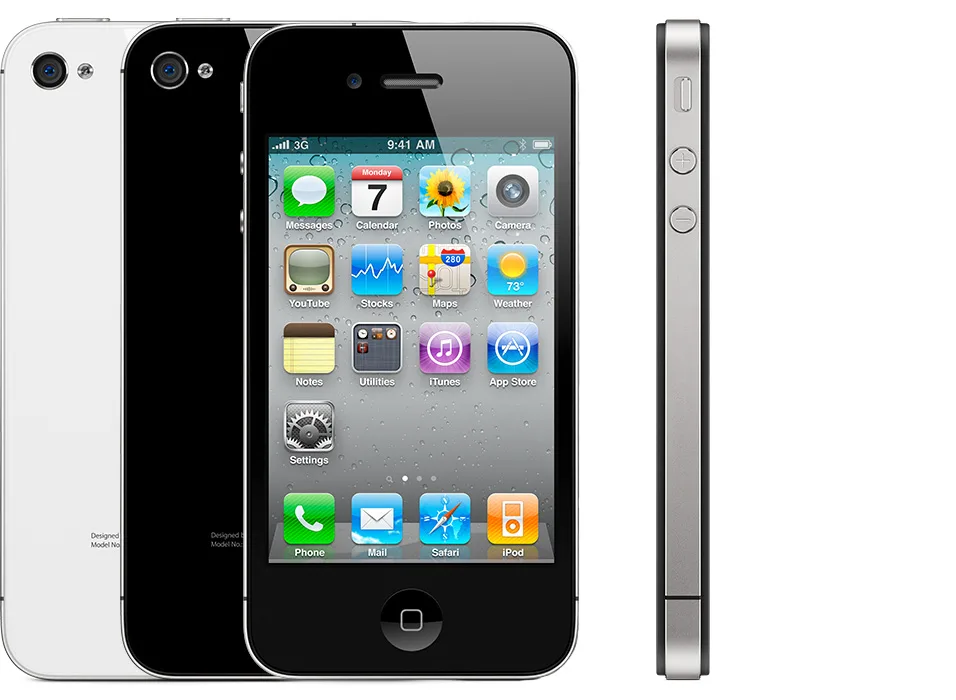
iOS Updates: iOS 4.0 – 4.3
Em June 2010, Apple introduced the first big redesign of the iPhone. The new model was available in two color options: black e herd. It brought a more elegant and modern design, with straighter lines, and featured a back made of tempered glass, surrounded by a stainless steel frame.
The screen remained with the 3,5 inches, but gained a technology created by Apple itself called retina screen, which displayed a resolution of 960 x 640 pixels. This screen has become a quality standard in the smartphone industry, offering sharper images. The iPhone 4 also increased performance with 512 MB of RAM, but kept storage options up to 32 GB.
When it comes to cameras, the iPhone 4 made a significant leap, going from 3,15 megapixels to 5 megapixels on the rear camera. This resulted in improvements in the quality of photos, making them sharper and more detailed. Furthermore, it made it possible to recording videos in high definition at 720p. Another highlight was the introduction of the VGA front camera, which could record videos in 480p, making the iPhone 4 a popular tool for creating multimedia content.
It was on the iPhone 4 that Apple debuted its first own processor, the Apple A4, which improved the overall performance of the device, making it faster and more efficient in multitasking.

This model also marked the beginning of FaceTime, a video calling service between iOS devices that revolutionized mobile communication and paved the way for the growing popularity of video calling on smartphones.
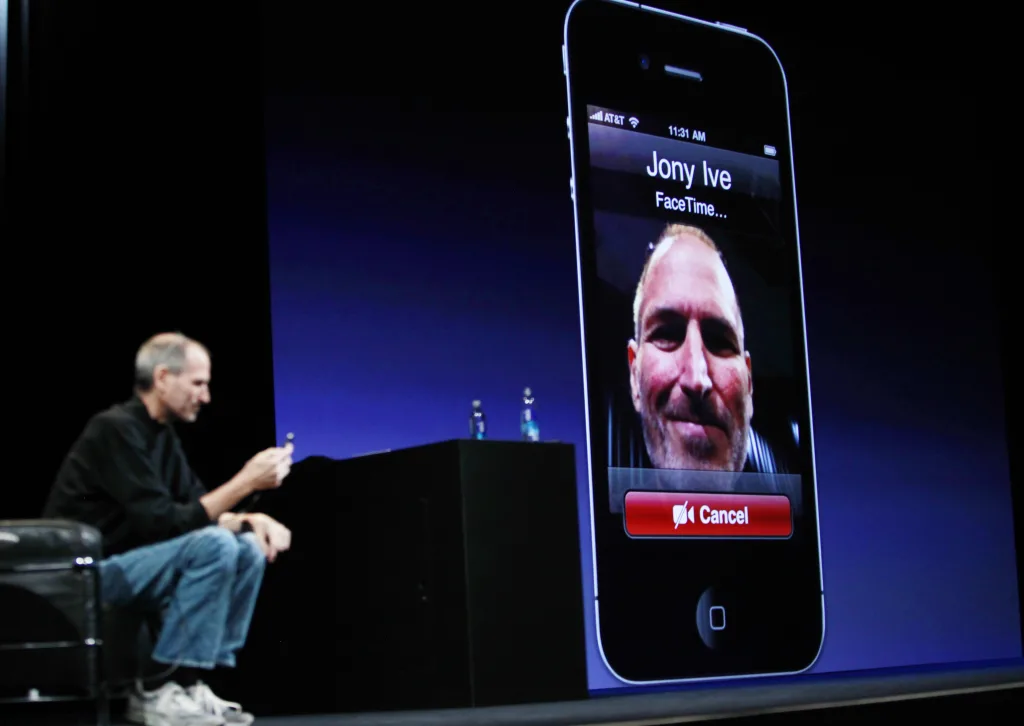
The changes in the iPhone 4 ended up causing some signal reception problems that were discovered over time. This was due to its integrated antenna, which wrapped around the device's stainless steel frame. When users held the iPhone 4 in a way that covered certain areas of the antenna, this could lead to a drop in signal quality and, in some cases, dropped calls.
iPhone 4s (2011)

iOS Updates: iOS 5.0 – 5.1
The iPhone 4's signal problem has finally been resolved with the launch of its successor, the iPhone 4s, in October 2011. The iPhone 4s not only fixed this issue, but also brought timely improvements and introduced new features that left a lasting mark on the history of the iPhone. Unlike the 3GS model, where the “s” stood for “Speed”, in the case of the iPhone 4s, according to Tim Cook himself, Apple's current CEO, the “s” referred to the newcomer Crab, Apple's intelligent voice assistant.
Siri, a feature that continues to be present on iPhones to this day, opened the door to interacting with your phone through voice commands. This allowed users to perform a variety of tasks, from sending text messages to making calls, setting reminders, and getting answers to questions.

The iPhone 4s also introduced the A5 chip dual-core. This update represented a considerable leap in the device's overall performance and processing capacity, resulting in an iPhone that is faster and more efficient at multitasking. The camera also received some improvements, such as an 8 megapixel rear camera, which allowed recording videos in Full HD. Additionally, features like image stabilization and a larger aperture enhanced the ability to take photos in low-light conditions.
The iPhone 4S was also responsible for ushering in the era of 4G connectivity with the introduction of the CDMA model, providing even faster data transfer speeds. The color options remained classic, remaining in the traditional black and white tones. However, the news came with the storage options, giving users the flexibility to choose between capacities of 16 GB, 32 GB and 64 GB.
iPhone 5 (2012)

iOS Updates: iOS 6.0 – 6.1
O iPhone 5, launched in September 2012, was the first model completely developed by Tim Cook and the last model supervised by Steve Jobs. He said goodbye to the old 3,5-inch screen that accompanied the device since its launch in 2007 and presented a larger screen. 4 inches, with a resolution of 1136 x 640 pixels, maintaining Retina quality. This model introduced a renewed look, thinner and lighter, abandoning the glass finish for a structure of aluminum.
Due to its new finish, color options now included Space Gray e Silver White. Regarding storage capacity, the iPhone 5 maintained the existing storage options 16 GB, 32 GB e 64 GB.
This device was a milestone in Apple's history, as it was responsible for debuting the lightning connector, a connection standard that replaced the old 30-pin connector. Furthermore, he inaugurated the 4G connection support, introducing LTE (Long-Term Evolution) technology, a high-speed wireless communications technology that enables faster and more efficient data transfers than previous 3G technologies.
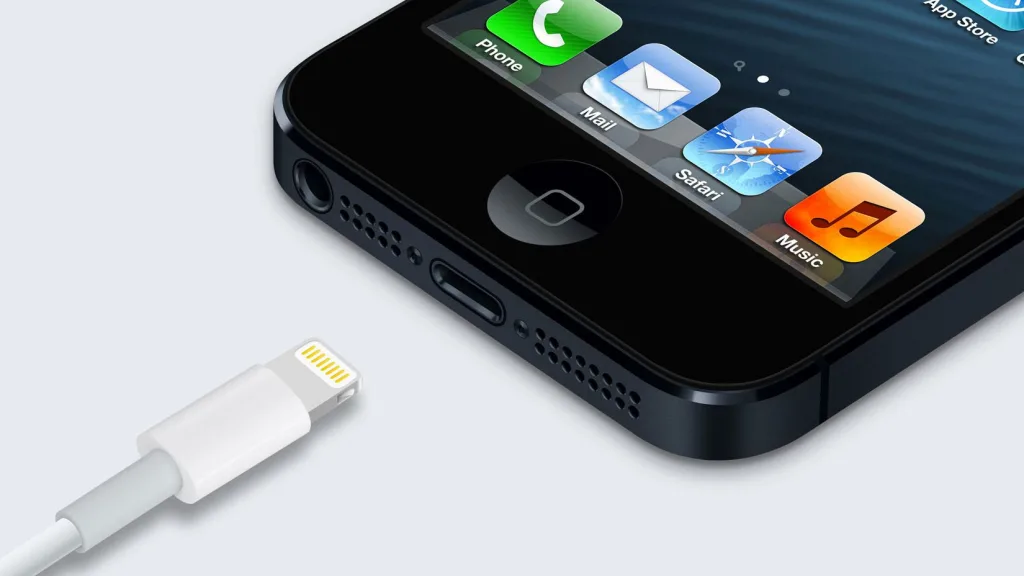
It also marked the debut of A6 chip dual-core and began to count on 1 GB of RAM, which considerably increased the performance and efficiency in terms of energy consumption of the device. Regarding the camera, the iPhone 8's 5 megapixel rear camera maintained high quality photos and videos in high definition (1080p), while the front camera received improvements to improve video calls and selfies.
iPhone 5s (2013)
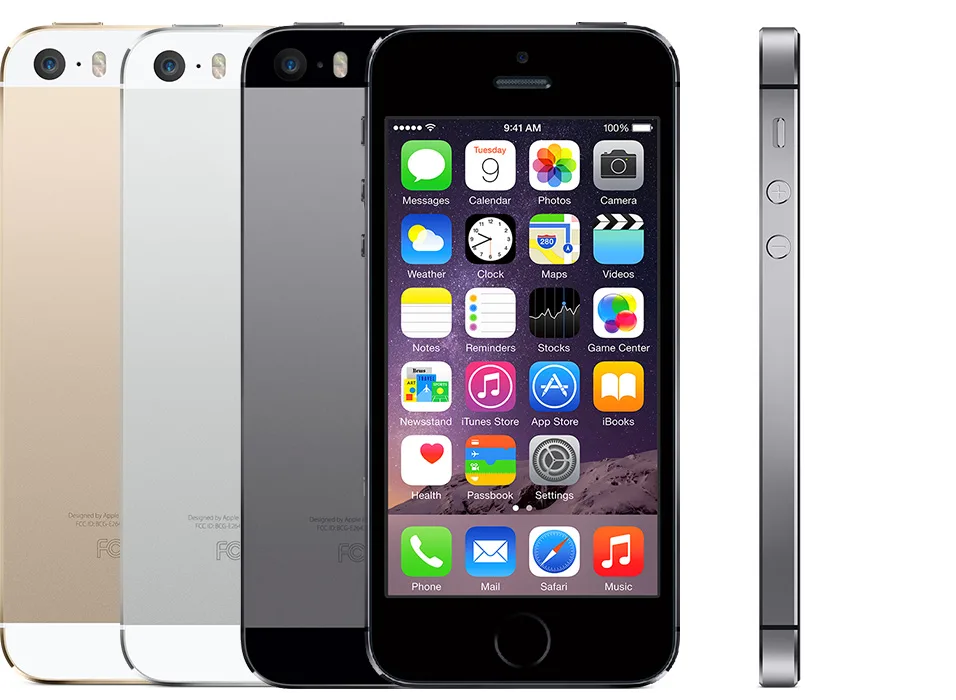
iOS Updates: iOS 7.0 – 7.1
O iPhone 5s reached users in September 2013 and despite maintaining the same classic look, presented on the iPhone 5, it brought some new features. One of the most notable changes was the introduction of touch ID, a fingerprint sensor located on the home button. With this new feature, users could unlock their devices and make payments quickly and securely, all with a simple tap of a finger.

With the arrival of A7 chip, marking the first 64-bit processor in a smartphone, the iPhone 5s also saw a significant improvement in terms of performance. Apple also brought the M7 co-processor, which is designed to handle health and movement-related tasks such as gyroscope, accelerometer, and compass. Among the notable innovations was the ability to record videos in slow motion at 120 frames per second and the introduction of Burst mode, which allowed users to take photos in an impressive burst of up to 10 frames per second.
As for the available colors, Apple brought some new features. In addition to the traditional options Space Gray e Silver White, consumers also had the option of purchasing the device in the Golden. However, in terms of storage capacity, the iPhone 5s remained among the options of 16 GB, 32 GB e 64 GB.
iPhone 5c (2013)
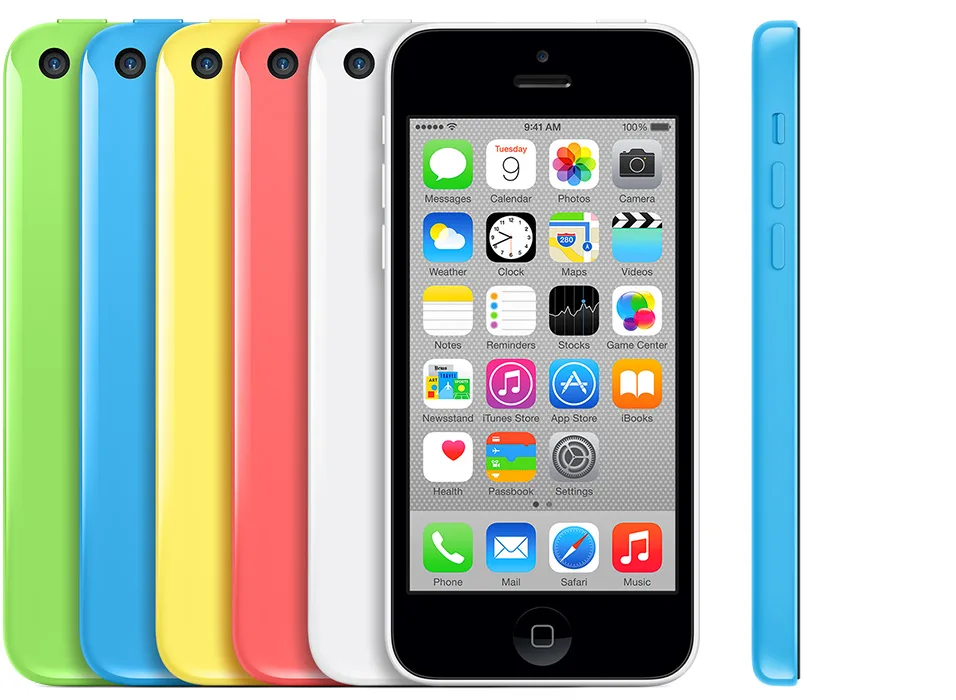
iOS Updates: iOS 7.0 – 7.1
Starting in 2013, Apple started to launch two iPhone models simultaneously, and the iPhone 5c was launched with the iPhone 5s as an alternative aimed at young audiences, with a colorful design and a most affordable price.
This was the company's first device to feature a body made of polycarbonate, which brought with it the same set of technical specifications as the iPhone 5, but wrapped in a vibrant casing available in colors blue, yellow, white, green e red. Unlike the iPhone 5s, the iPhone 5c was only available in 8 GB, 16 GB e 32 GB.
iPhone 6 and iPhone 6 Plus (2014)
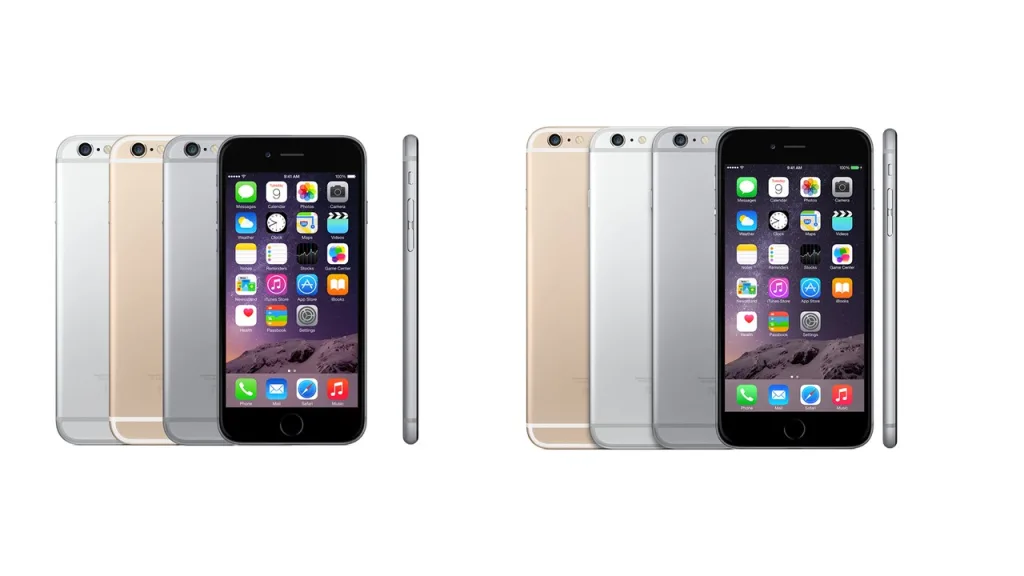
iOS Updates: iOS 8.0 – 8.4
Following the tradition of launching two iPhones per year, in 2014 Apple presented the iPhone 6 and the 6 iPhone Plus. These models marked a new era in the evolution of iPhones, bringing significant changes to their design and screen size. Both presented a thinner construction e elegance, rounded corners e aluminum housings.
For the first time, Apple introduced an iPhone with a considerably larger screen. The iPhone 6 had a screen 4,7 inches, while the iPhone 6 Plus stood out with a 5,5 inches. In addition to screen size, the most notable differences between the devices included the optical stabilization system on the camera, the screen resolution (750 x 1334 pixels on the iPhone 6 and 1080 x 1920 pixels, Full HD, on the iPhone 6 Plus) and the battery, which was larger on the 6 Plus model. In other respects, they shared the Apple A8 processor, options up to 128 GB storage, 1 GB of RAM and a rear camera 8 SM.
The year 2014 also marked the introduction of Apple Pay, a contactless payment system that uses NFC technology, which allowed users to make payments securely using their iPhones.
iPhone 6s and iPhone 6s Plus (2015)
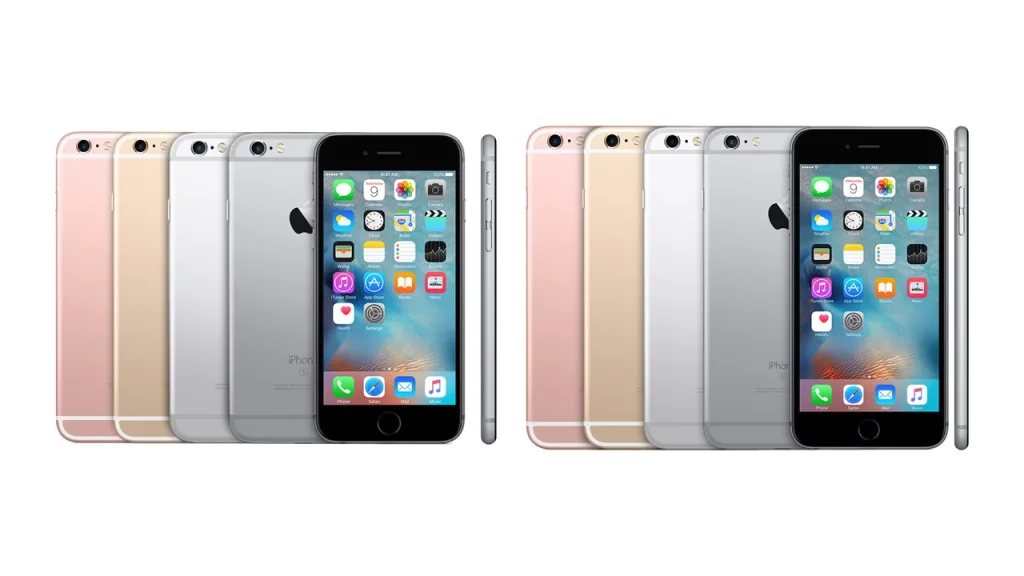
iOS Updates: iOS 9.0 – 9.3
Os iPhones 6s e 6s Plus, released in September 2015, maintained the design and screen of its predecessors, but brought some significant improvements. One of the innovations that attracted the most attention was the introduction of technology Touch 3D, which allowed users to interact more sensitively with the screen. With 3D Touch, pressure exerted on the screen could trigger different actions and shortcuts, generating interactions on icons on the home screen and even in applications, providing a more intuitive and efficient user experience.
In terms of performance, they were equipped with the A9 chip from Apple, which offered a significant increase in speed and efficiency while maintaining the Apple chip sequence that has been evolving since 2010. Additionally, RAM capacity was increased to 2 GB, further improving multitasking performance. The rear camera has seen a jump from 8 MP to 12 SM, Besides the ability to record 4K videos. The front camera has been updated to 5 megapixels, improving selfies and video calls.
Storage options have not been added compared to the previous generation, with models available in 16 GB, 64 GB e 128 GB. However, an interesting new feature was the introduction of color Rose gold, which joined the traditional options of Space Gray, Silver e Golden.
iPhone SE – 1st generation (2016)
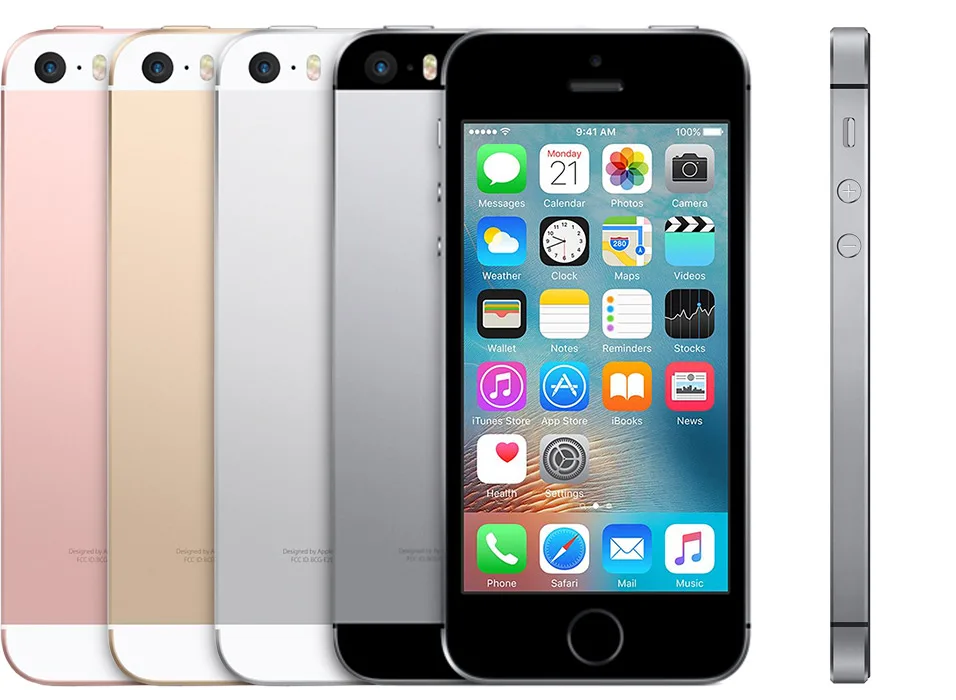
iOS Updates: iOS 10.0 – 10.3
O iPhone SE, launched in March 2016, brought a combination of the classic design of the iPhone 5s with more updated internal hardware, incorporating some features of the iPhone 6s. This model was created to meet the demands of users who preferred a smaller and more accessible device, while maintaining the 4-inch Retina display and the aluminum structure of the iPhone 5s. The iPhone SE was equipped with a processor A9 and a 12 megapixel rear camera, capable of capturing high-quality photos and videos, while the front camera 1,2 megapixels it was suitable for selfies and video calls.
For many, the iPhone SE was seen as the spiritual successor to the iPhone 5c, meeting the demand for a compact, effective and lower-cost device than the other traditional models in the line.
iPhone 7 and iPhone 7 Plus (2016)
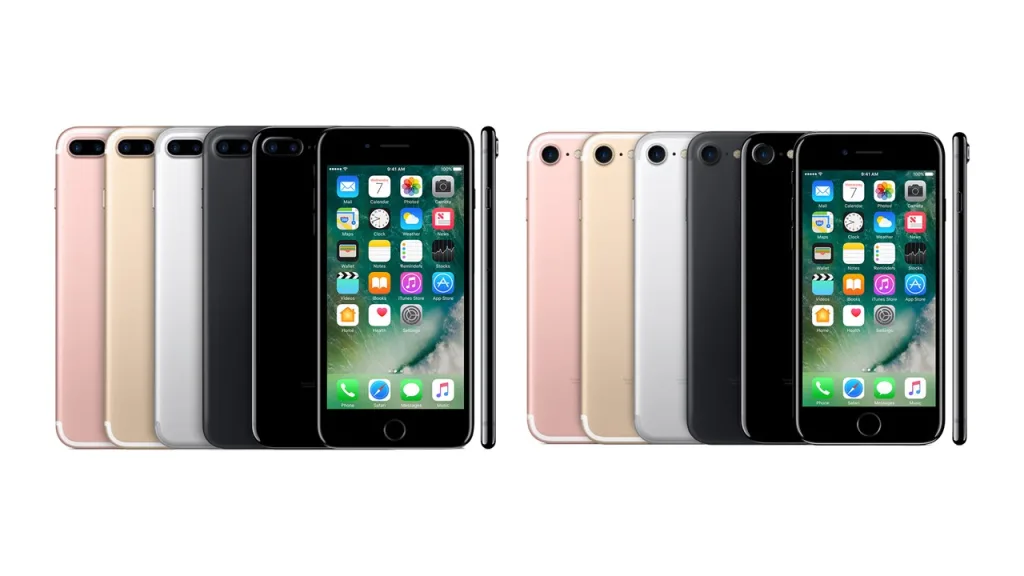
iOS Updates: iOS 10.0 – 10.3
Without a doubt, the iPhone 7 and the 7 iPhone Plus, launched in 2016, were a milestone in Apple's history, bringing not only innovations, but also some controversies. In general terms, these models maintained the design and screen of the previous generation, but one of the most visible changes was the 3,5mm headphone jack removal. This allowed Apple to make iPhones thinner and make room for other improvements, but it also resulted in users needing to use wireless headphones or adapters to use regular headphones with the Lightning connector, generating some controversy.

It is worth highlighting that, at the same event, Apple announced its AirPods, your new wireless headphones.

With the introduction of A10 Fusion chip, the performance of devices has been significantly improved. Furthermore, the iPhone 7 Plus stood out for having 1 GB more RAM memory more than the iPhone 7 which only had 2GB. The Plus model brought an extra 12 MP camera for 3x optical zoom and background blur effects (portrait mode). Both models also showed improvements in front camera with 7 MP resolution, providing high-quality selfies.
A significant addition was the IP67 certification, which provided water and dust resistance to the devices. This meant that the devices could withstand brief submersion in water and provide greater durability in certain environments.
The storage capacity also underwent a review, abandoning the 16 GB and 64 GB versions and offering models with 32 GB, 128 GB e 256 GB for both models. As for colors, the new generation introduced some new features, in addition to the classic options. Rose Gold, Gold e Silver, the new colors Matte Black e Bright black. The iPhone 7 was the first Apple smartphone to receive the version (PRODUCT) RED. This model is part of a collection of products whose sales contribute to raising funds to combat diseases such as AIDS, tuberculosis and malaria, mainly in Africa.

iPhone 8 and 8 Plus (2017)
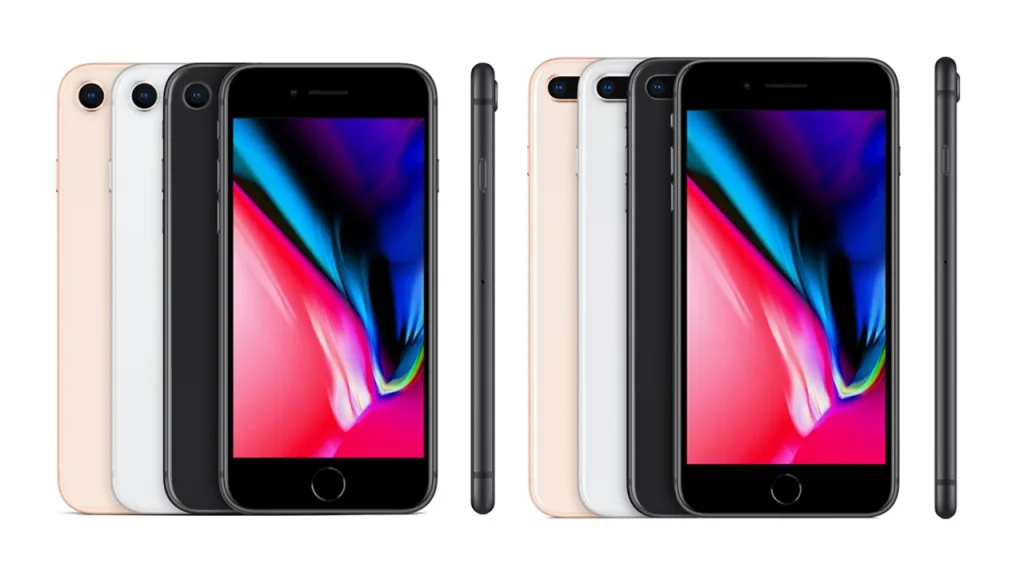
iOS Updates: iOS 11.0 – 11.4
In 2017, Apple launched models iPhone 8 e 8 iPhone Plus, bringing small updates compared to its predecessors. While the overall design remained similar, both devices received a major update with the introduction of glass panels on the rear, making them compatible with Qi wireless charging technology.
The iPhones 8 were equipped with the chip Six-core A11 Bionic e 12 megapixel rear cameras, with the iPhone 8 Plus offering a dual camera setup, has elevated photo quality from one generation to the next, ensuring sharper photos and advanced augmented reality features.
Apple has revised the storage capacity options, and in addition to the 128 GB e 256 GB, she once again offered models with 64 GB which had been left aside in 2016. As for colors, the options included the classic Gold, Silver, Space Gray and editing (PRODUCT) RED.
iPhone X (2017)

iOS Updates: iOS 11.0 – 11.4
In 2017, Apple marked a decade of innovation since the launch of the first iPhone, and to celebrate this milestone, it introduced the world to iPhone X, which brought a major revolution in smartphone design and technologies, marking the biggest visual change since the debut of the original iPhone. With one Super Retina OLED display, practically without edges, 5,8 inches, this was the first time that Apple used an OLED panel in a cell phone. Furthermore, she introduced the Face ID, an advanced 3D facial recognition system for biometric authentication, replacing the traditional Home button with Touch ID.

The arrival of the chip A11 Bionic further improved its performance and 12 megapixel dual rear camera brought optical image stabilization on both lenses, ensuring exceptional photos and videos even in low-light conditions. In addition front camera now supports portrait mode, allowing selfies with background blur effects. Another innovation was the Animoji, a feature that allowed users to create animated emojis based on their facial expressions, taking advantage of the TrueDepth camera.

The iPhone X was launched with two color options, space gray e Silver, and offered storage capacity in 64 GB e 256 GB.
iPhone XS and iPhone XS Max (2018)

iOS Updates: iOS 12.0 – 12.1
In 2018, with the launch of iPhone XS e XS Max, Apple consolidated the trend for Virtually borderless screens and the use of Face ID. These new models maintained the iPhone X design, with its stainless steel e Super Retina OLED display.
The main difference between the devices was in the screen size: the iPhone XS remained with the 5,8 inch screen, while the iPhone XS Max presented a larger version, achieving incredible 6,5 inches, making it one of the largest smartphones ever produced by Apple.
Both models received the chip A12 Bionic, Apple's first 7-nanometer processor. Camera quality has also received improvements, with both models featuring a 12 megapixel dual camera, including wide-angle and telephoto lenses on the rear, in addition to the ability to record 4K videos at 60 frames per second. Portrait mode has been improved, giving you even more stunning background-blurred photos, along with a 7 megapixel front camera to take high-quality selfies.
They were released in colors Space Gray, Silver and Gold. Additionally, both models offered storage options for 64 GB, 256 GB and a new, spacious version with 512 GB which came to meet the diverse storage space needs of users.
iPhone XR (2018)
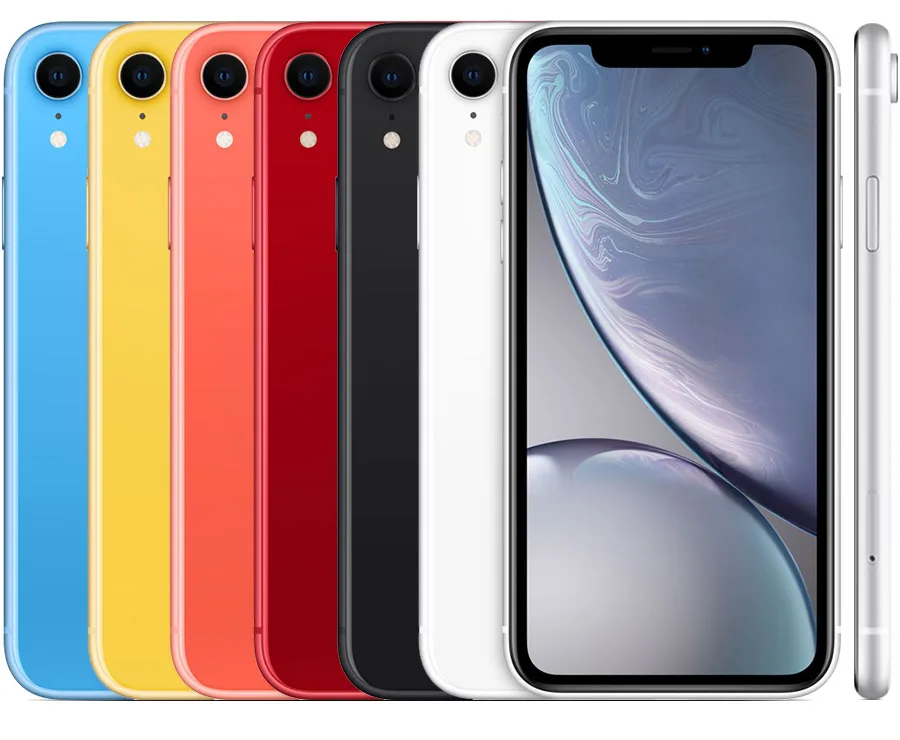
iOS Updates: iOS 12.0 – 12.1
In 2018, along with the iPhones XS and XS Max, Apple introduced the iPhone XR, which stood out as the most affordable option of the generation. This model adopted the design introduced by the iPhone X, incorporating a screen 6,1-inch Liquid Retina HD. One of the notable differences in relation to the XS models was the choice of a LCD screen instead of OLED technology, which resulted in slightly lower image quality compared to other models in the XS series.
Internally, the iPhone XR shared the powerful chip A12 Bionic with its XS Series counterparts, ensuring fast and efficient performance on every task. Despite having only a 12 megapixel rear camera, it did not disappoint in terms of image quality.
A distinctive feature of the XR was its range of vibrant colors, which included options in White, Black, Blue, Yellow, Coral and editing (PRODUCT) RED. Consumers also had flexibility in choosing storage capacity between 64 GB, 128 GB e 256 GB.
iPhone 11, iPhone Pro and iPhone 11 Pro Max (2019)
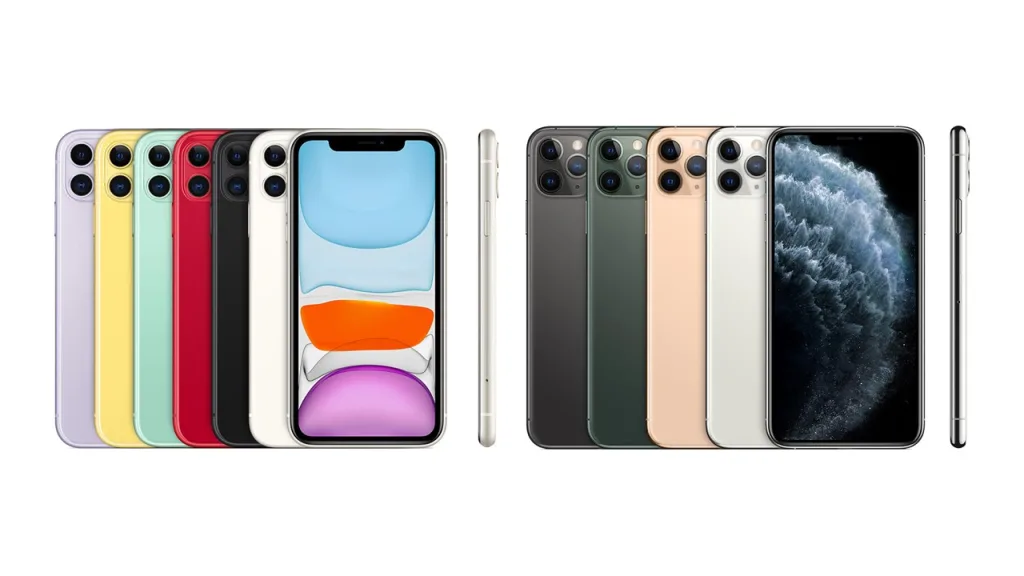
iOS Updates: iOS 13.0 – 13.1
In 2019, Apple chose to simplify the naming of its devices, with the iPhone 11 succeeding the iPhone XR, and the models iPhone 11 Pro e 11 Pro Max as successors to the iPhone XS and XS Max, respectively.
O iPhone 11 was the entry-level version, featuring a design similar to the iPhone XR, with a 6,1-inch Liquid Retina HD LCD display, which practically extends to the edges of the device. He also brought the new chip A13 Bionic, which brought a notable increase in the performance and efficiency of the device. One of the biggest innovations was the improvement in camera quality. The iPhone 11 brought a 12 megapixel dual camera on the back, made up of a wide-angle and an ultra-wide-angle lens. In addition 12 megapixel front camera received improvements for selfies, and features such as Night mode were introduced, further improving photo quality in low-light conditions.

This model was sold in the colors Black, White, Green, Yellow, Purple e (PRODUCT) RED and offered storage options for 64 GB, 128 GB e 256 GB.
Talking a little about the models 11 Pro e 11 Pro Max, it is possible to observe a difference in relation to the standard model. These devices display a more premium finish with stainless steel sides and a frosted glass back cover. Additionally, they feature a screen High quality Super Retina XDR with 5,8 inches on the Pro model and a 6,5 inches in the Pro Max model. Both are equipped with the powerful chip A13 Bionic, supplemented by 4 GB of RAM, a specification also found in the entry model.
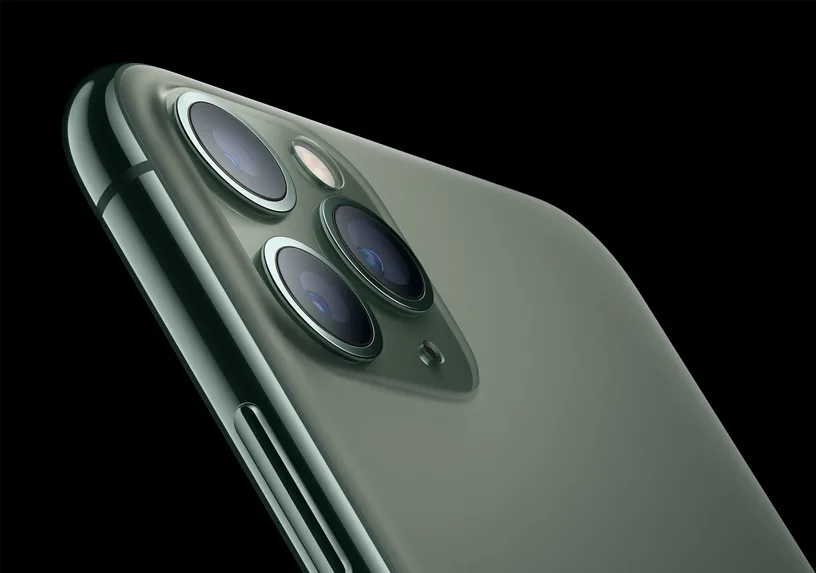
iOS Updates:
The big difference between these devices is the camera setup. The 11 Pro and 11 Pro Max have a 12 megapixel triple camera, composed of an ultra-angle lens, a wide-angle lens and a telephoto lens, capable of recording 4K videos with extended dynamic range e kinematic video stabilization.
The Pro and Pro Max models were available in more discreet colors, such as Space Gray, Silver, Gold e Midnight Green. In terms of storage, in addition to the storage options 64 GB e 256 GB, these models also had an option to 512 GB.
iPhone SE – 2nd generation (2020)

iOS Updates: iOS 14.0 – 14.8
O second generation iPhone SE, released in 2020, combined the iconic aesthetics of the iPhone 8 with the powerful performance of the iPhone 11. This device paid homage to Apple's classic design, maintaining the look with the fingerprint reader, while incorporating newer technologies.
He incorporated a 4,7-inch widescreen Retina HD LCD display, bringing back the home button with Touch ID e visible edges. Powered by the chip A13 Bionic, the same processor found in the iPhone 11 models. 12 megapixel rear camera, although unique, managed to capture high quality photos and record videos in 4K. 7 megapixel front camera it also delivered great results for selfies and video calls.
The second generation of the SE was launched in the colors Black White e (PRODUCT) RED and offered storage options in 64 GB, 128 GB e 256 GB. This launch reinforced Apple's commitment to meeting the diverse needs of its audience, providing an affordable and compact smartphone without leaving aside essential features.
iPhone 12 mini, iPhone 12, iPhone 12 Pro and iPhone 12 Pro Max (2020)

iOS Updates: iOS 14.0 – 14.8
In addition to the iPhone SE, 2020 was also marked by the arrival of new models iPhone 12 mini, iPhone 12, iPhone 12 Pro e iPhone 12 Pro Max, this being the first time in history that Apple launched four devices from the same line at once. Although all of these devices share a similar design, they feature different levels of performance and features to meet the diverse needs of users.
O iPhone 12mini brought a compact design with a screen 5,4-inch Super Retina XDR, making it the lightest and most portable iPhone in the lineup. Already the iPhone 12 brought a screen 6,1-inch Super Retina XDR and just as the Mini model was also equipped with the chip A14 Bionic, the same processor found in the larger models in the series. Both models shared dual rear cameras. 12 megapixels, managing to capture high quality photos and videos.

The 12 mini and 12 models brought different color options, such as black, white, green, blue, purple and editing (PRODUCT) RED. Additionally, they were available in different storage capacities, offering users storage options. 64 GB, 128 GB e 256 GB.
Os iPhone 12 Pro e 12 Pro Max were launched as more premium options. They were equipped with 6,1-inch Super Retina XDR displays e 6,7 inches, respectively, with support for HDR and powered by the chip A14 Bionic. The 12 megapixel triple rear cameras They had an ultra-wide-angle lens, a wide-angle lens and a telephoto lens. These camera configurations allowed for a wide range of advanced photographic features, such as night mode and the ability to record videos in Dolby Vision HDR.

The Pro models also stood out for their stainless steel construction and variety of color options, including Graphite, Silver, Gold e Pacific Blue. Additionally, they were available in different storage capacities, offering users storage options. 128 GB, 256 GB e 512 GB.
In addition to all these improvements, the iPhone 12 line became Apple's first to offer support for 5G networks, providing much faster mobile connectivity speeds compared to previous generations.
iPhone 13 mini, iPhone 13, iPhone 13 Pro and iPhone 13 Pro Max (2021)

iOS Updates: iOS 15 – 15.2
In 2021, Apple maintained its tradition of launching four iPhone models: the iPhone 13 mini, iPhone 13, iPhone 13 Pro e iPhone 13 Pro Max. All of these devices share a similar design but offer different levels of performance and features. Overall, they've brought significant improvements to the camera's hardware and capabilities, including support for the Cinema mode, which allows you to create videos with a background blur effect. Furthermore, there was a notable reduction in the size of the Face ID notch, without compromising the effectiveness and security of this biometric system.
O iPhone 13mini and the iPhone 13 kept the well-known screens Super Retina XDR OLED, with sizes of 5,4 e 6,1 inches, respectively. Both were equipped with the chip A15 Bionic, the same processor found in the larger models in the series. Additionally, they shared 12 megapixel dual rear camera, allowing you to capture high-quality photos and videos.
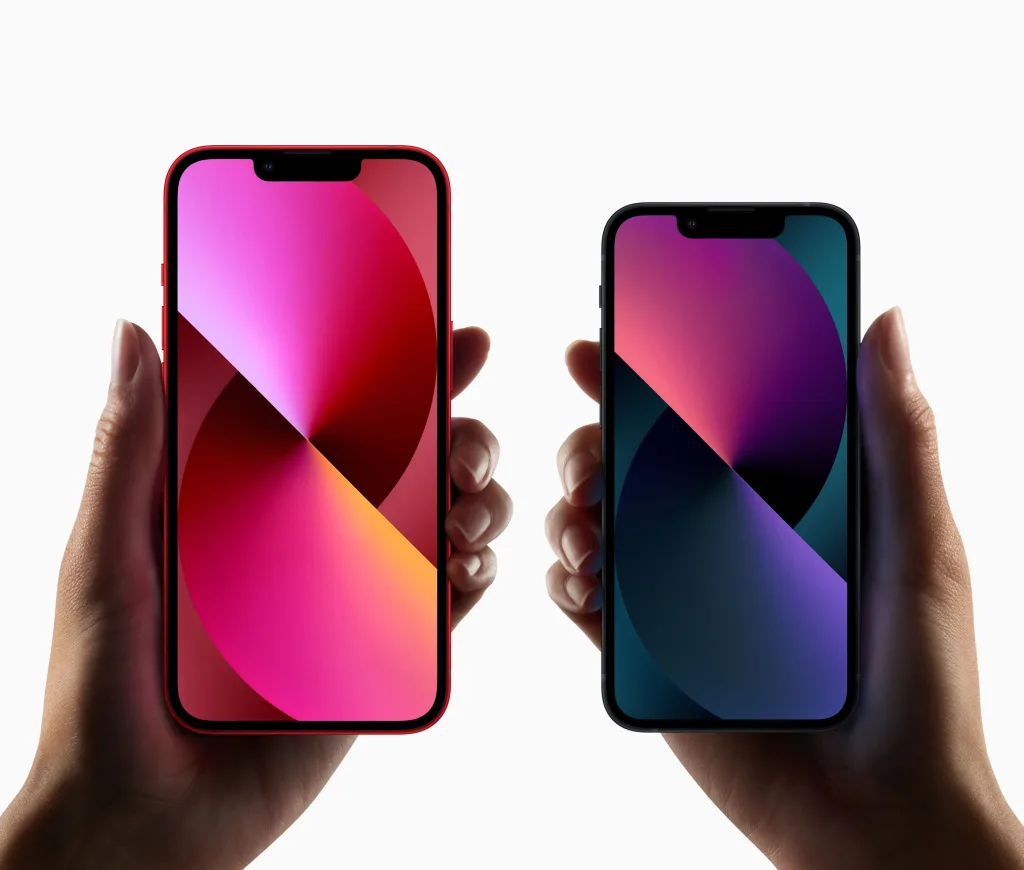
As with the previous generation, the 13 mini and 13 models offered a wide variety of color options, including stellar, midnight, blue, pink, green e (PRODUCT) RED. They were also made available in various storage capacities, such as 128 GB, 256 GB and, for the first time, in the version of 512 GB, which was previously reserved only for the highest performance models.
The models 13 Pro e 13 Pro Max stood out as the most premium options. They presented screens Super Retina XDR with ProMotion technology, with sizes of 6,1 e 6,7 inches, respectively, powered by the same chip A15 Bionic. The camera configuration remained with a 12 megapixel triple camera, including wide-angle, ultra-wide-angle and telephoto lenses. However, the highlights of the new line were reserved for the iPhone 13 Pro Max, which exclusively introduced the technology Shift Sensor of stabilization on the photographic sensor and a new telephoto lens with 5x optical zoom, without loss of quality.
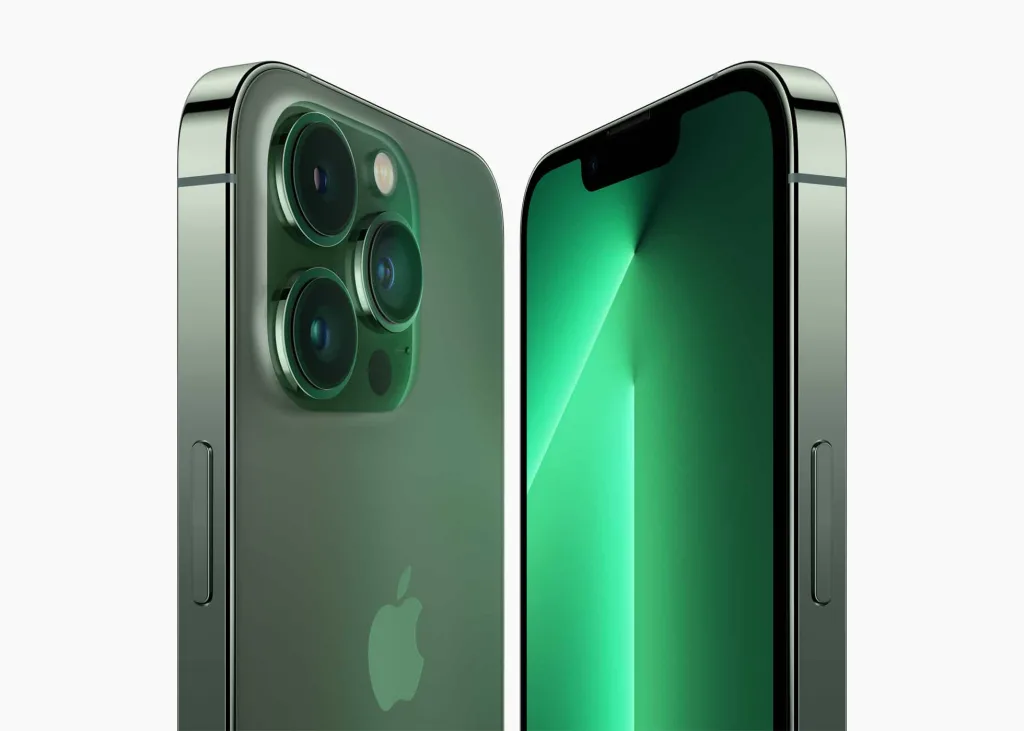
These models also brought new color options, such as Graphite, Gold, Silver, Sierra Blue e Alpine Green. In addition to storage options for 128 GB, 256 GB e 512 GB. This new generation also included an additional option of 1 TB of storage, being the largest launched in the history of iPhones.
iPhone SE – 3st generation (2022)

iOS Updates: iOS 15 – 15.2
In 2022, Apple introduced the third generation iPhone SE, maintaining the tradition of offering an affordable device with a touch of nostalgia, combining the classic design of the iPhone 8 with powerful hardware and 5G connectivity. This model had a retina screen 4,7 inch HD LCD and the iconic home button with Touch ID.
Under the hood, the iPhone SE (3rd generation) is driven by the chip A15 Bionic from Apple, a newer version of the powerful processor found in the iPhone 13. As far as cameras go, it features a single 12-megapixel rear camera and a 7 megapixel front camera. While it doesn't offer the advanced camera settings of the Pro models, it can still capture high-quality photos and record 4K videos.
The color options were very limited and only included the models Midnight, Starfire e (PRODUCT) NETWORK. The storage options brought versions of 64 GB, 128 GB e 256 GB.
iPhone 14, iPhone 14 Plus, iPhone 14 Pro and iPhone 14 Pro Max (2022)

iOS Updates: iOS 16
Two years after the launch of the first iPhone Mini, Apple made the decision to end this line in 2022, giving way to the model More, which brought a screen of 6,7 inches. In addition to the new Plus model, the company also presented the traditional iPhone 14, iPhone 14 Pro e iPhone 14 Pro Max.
The models 14 e 14 Plus kept the chip A15 Bionic and the already known Super Retina XDR display, with sizes of 6,1 inches e 6,7 inches, respectively. Accompanied by two 12 MP cameras, one ultra-angle and one wide-angle, and one 12 MP front camera. These models were launched in colors midnight, stellar, (PRODUCT)RED, blue, purple e yellow, with storage options in 128 GB, 256 GB e 512 GB.

The premium duo composed of iPhone 14 Pro e 14 Pro Max were the ones that brought the most innovations. Beyond the screens 6,1 Borderless Super Retina XDR e 6,7 inches, these models introduced a new feature called “Dynamic Islands” or “Dynamic Island” in Portuguese. This pill-shaped notch now allows the user to check all notifications more conveniently, including phone calls, directions on Maps and music control on Apple Music. Another exclusive feature of this duo was the incorporation of the advanced processor A16 Bionic, along with a main camera that has made an impressive leap to 48 SM.

These models were launched in more sophisticated colors, such as silver, gold, space black e deep Purple, with storage options for 128 GB, 256 GB, 512 GB e 1 TB.
iPhone 15, iPhone 15 Plus, iPhone 15 Pro e iPhone 15 Pro Max (2023)
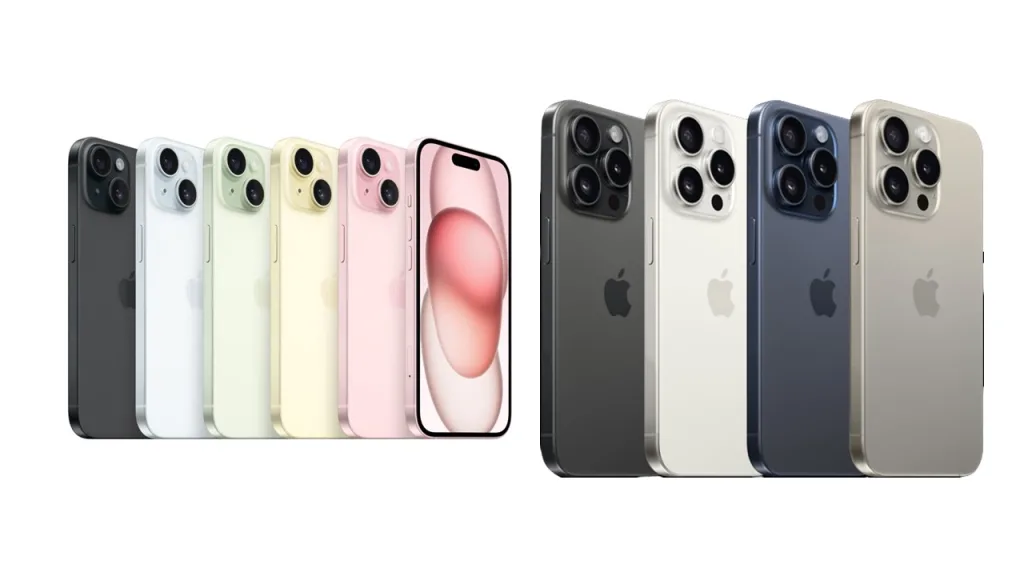
iOS Updates: iOS 17
Last Tuesday, day September 12, Apple held its long-awaited annual event, where the long-awaited iPhone 15, iPhone 15 Plus, iPhone 15 Pro e iPhone 15 Pro Max. The biggest and most impactful news of this launch was the arrival of USB-C connection for all models, marking the definitive retirement of the Lightning connector, which, in a way, had been limiting the device's usability capabilities.

O iPhone 15 and the iPhone 15 More respectively bear 6,1-inch Super Retina XDR displays e 6,7 inches, both now benefiting from the ceramic protection (Ceramic Shield), providing greater durability of the device. These models are powered by the chip A16 Bionic, which not only offers exceptional performance, but also stands out for its improved energy efficiency, resulting in battery consumption of up to 20% more efficient. A notable addition to these templates is the inclusion of the long-awaited Dynamic Islands, previously restricted to Pro versions, and a significant improvement in the resolution of the main camera, which now has 48 SM.
The models 15 Pro e 15 Pro Max kept their screens 6,1 e 6,7 inches, but they brought a titanium body, making the device even lighter. Equipped with the processor Bionic A17 Pro, they offer exceptional performance, especially optimized for demanding tasks such as video editing and augmented reality. When it comes to photography, the duo impresses with a triple cameras which incorporates the same main camera as 48 SM, a 12 MP ultra wide angle and a new 12 MP telephoto camera.

However, one of the biggest innovations of these models is in the improved action button, capable of activating a variety of functions, such as voice recording, camera control and pre-programmed shortcuts, making the user experience even more intuitive and versatile.
The models iPhone 15 and the iPhone 15 More will offer a selection of colors that includes black, blue, green, yellow e pink, while the models 15 Pro e 15 Pro Max will be available in colors Natural titanium, Blue titanium, White titanium e Black Titanium. In the Brazilian market, these devices will be available at the following prices:
- iPhone 15:
- iPhone 15 128 GB – R$ 7.299;
- iPhone 15 256 GB – R$ 8.099;
- iPhone 15 512 GB – R$ 9.599.
- 15 iPhone Plus:
- iPhone 15 More 128 GB – R$ 8.299;
- iPhone 15 More 256 GB – R$ 9.099;
- iPhone 15 More 512 GB – R$ 10.599.
- iPhone 15 Pro:
- iPhone 15 Pro 128 GB – R$ 9.299;
- iPhone 15 Pro 256 GB – R$ 10.099;
- iPhone 15 Pro 512 GB – R$ 11.599;
- iPhone 15 Pro 1TB – R$ 13.099.
- iPhone 15 Pro Max:
- iPhone 15 Pro 256 GB – R$ 10.999;
- iPhone 15 Pro 512 GB – R$ 12.499;
- iPhone 15 Pro 1TB – R$ 13.999.
So, did you like our post? So tell us here in the comments which of these models you've had and be sure to share our post with your friends and follow our website to stay up to date with everything that's going on in the world of technology.
See also:
Also check out other related content on showmetech. Apple launches iPhone 15 with USB-C input, titanium Pro models and more!
Source: Apple
reviewed by Glaucon Vital em 22 / 9 / 23.



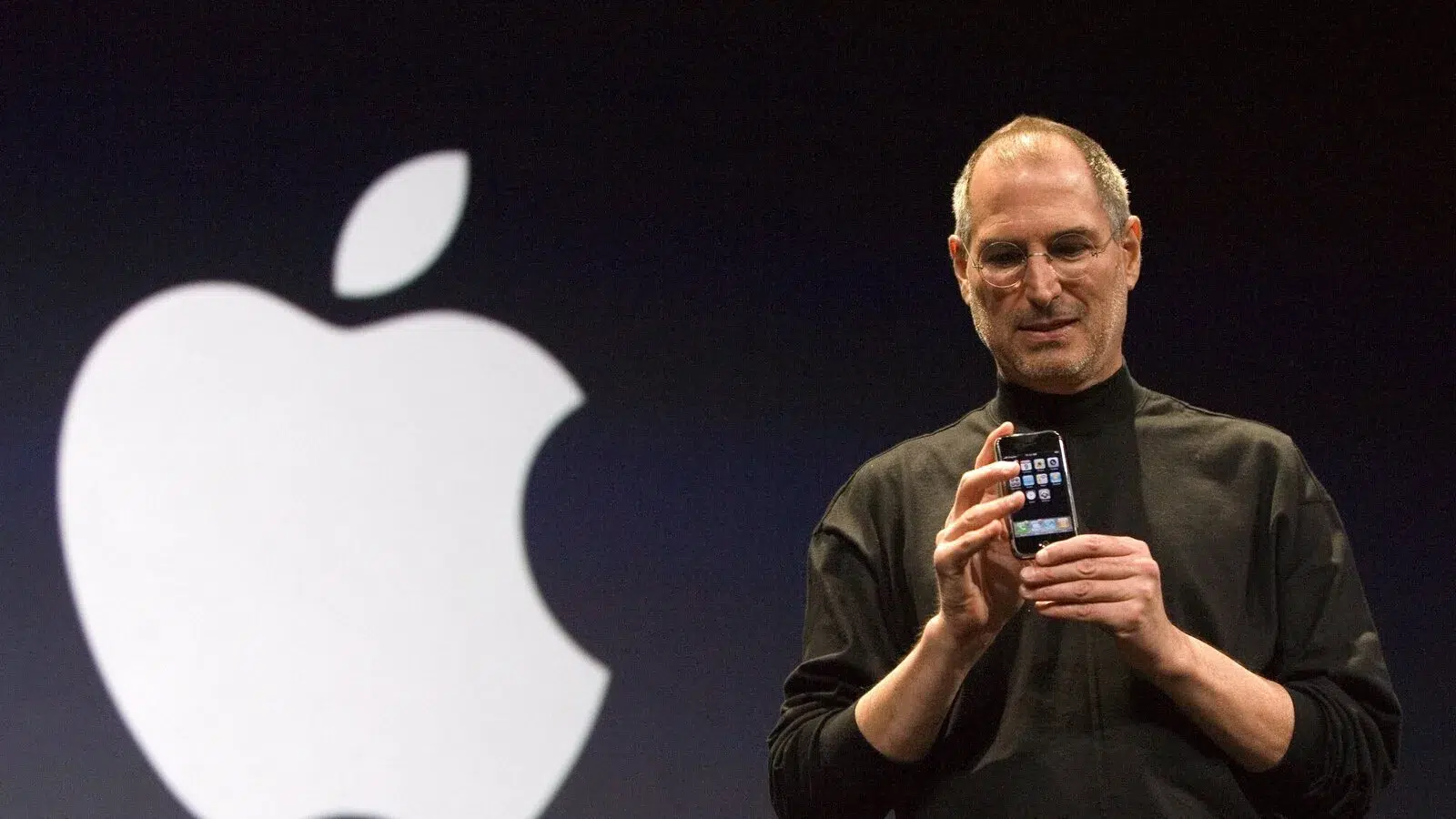



BRABO DMS